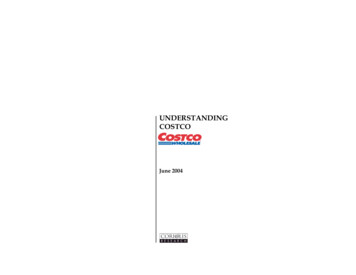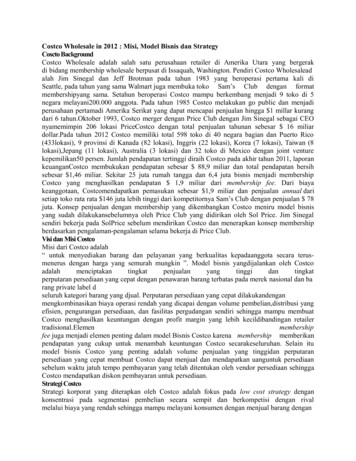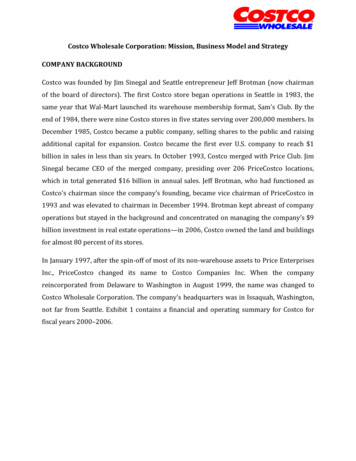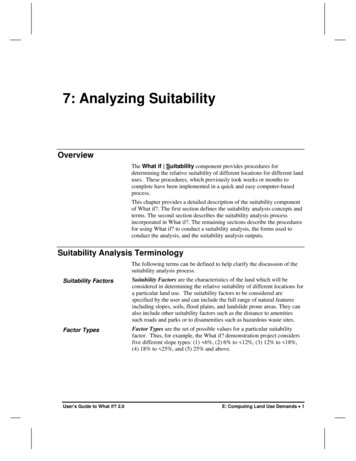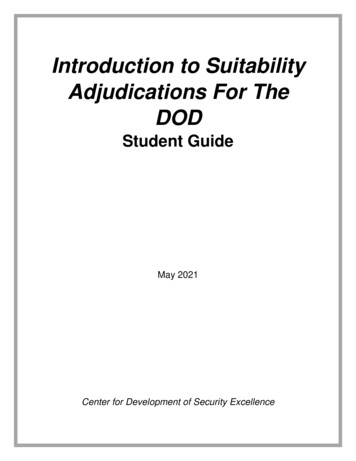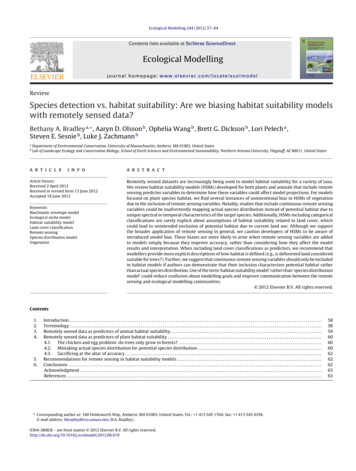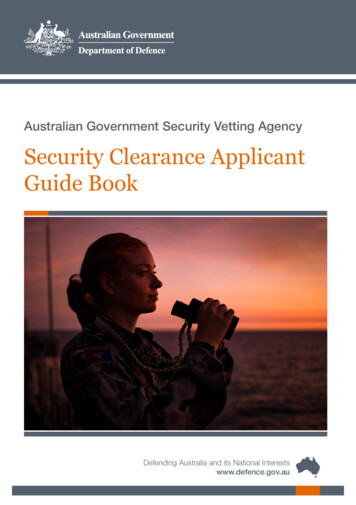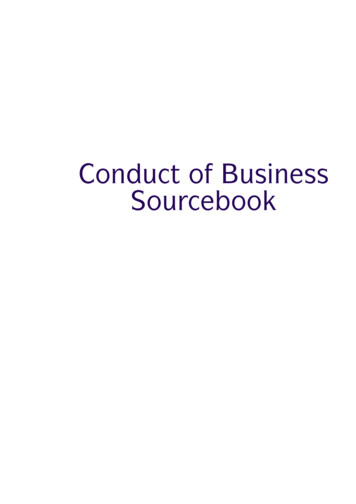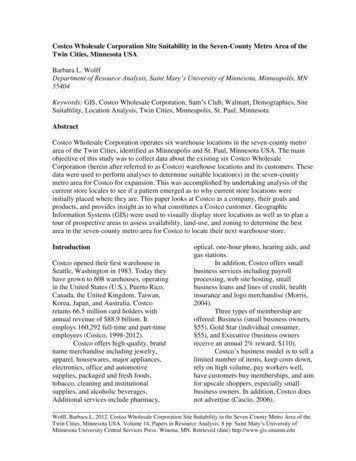
Transcription
Costco Wholesale Corporation Site Suitability in the Seven-County Metro Area of theTwin Cities, Minnesota USABarbara L. WolffDepartment of Resource Analysis, Saint Mary’s University of Minnesota, Minneapolis, MN55404Keywords: GIS, Costco Wholesale Corporation, Sam’s Club, Walmart, Demographics, SiteSuitability, Location Analysis, Twin Cities, Minneapolis, St. Paul, MinnesotaAbstractCostco Wholesale Corporation operates six warehouse locations in the seven-county metroarea of the Twin Cities, identified as Minneapolis and St. Paul, Minnesota USA. The mainobjective of this study was to collect data about the existing six Costco WholesaleCorporation (herein after referred to as Costco) warehouse locations and its customers. Thesedata were used to perform analyses to determine suitable location(s) in the seven-countymetro area for Costco for expansion. This was accomplished by undertaking analysis of thecurrent store locales to see if a pattern emerged as to why current store locations wereinitially placed where they are. This paper looks at Costco as a company, their goals andproducts, and provides insight as to what constitutes a Costco customer. GeographicInformation Systems (GIS) were used to visually display store locations as well as to plan atour of prospective areas to assess availability, land-use, and zoning to determine the bestarea in the seven-county metro area for Costco to locate their next warehouse store.optical, one-hour photo, hearing aids, andgas stations.Costco opened their first warehouse inIn addition, Costco offers smallSeattle, Washington in 1983. Today theybusiness services including payrollhave grown to 608 warehouses, operatingprocessing, web site hosting, smallin the United States (U.S.), Puerto Rico,business loans and lines of credit, healthCanada, the United Kingdom, Taiwan,insurance and logo merchandise (Morris,Korea, Japan, and Australia. Costco2004).retains 66.5 million card holders withThree types of membership areannual revenue of 88.9 billion. Itoffered: Business (small business owners,employs 160,292 full-time and part-time 55), Gold Star (individual consumer,employees (Costco, 1998-2012). 55), and Executive (business ownersCostco offers high-quality, brandreceive an annual 2% reward, 110).name merchandise including jewelry,Costco’s business model is to sell aapparel, housewares, major appliances,limited number of items, keep costs down,electronics, office and automotiverely on high volume, pay workers well,supplies, packaged and fresh foods,have customers buy memberships, and aimtobacco, cleaning and institutionalfor upscale shoppers, especially smallsupplies, and alcoholic beverages.business owners. In addition, Costco doesAdditional services include pharmacy,not advertise (Cascio, 2006).IntroductionWolff, Barbara L. 2012. Costco Wholesale Corporation Site Suitability in the Seven-County Metro Area of theTwin Cities, Minnesota USA. Volume 14, Papers in Resource Analysis. 8 pp. Saint Mary’s University ofMinnesota University Central Services Press. Winona, MN. Retrieved (date) http://www.gis.smumn.edu
To turn inventory quickly, a typicalCostco stocks 4,000 items: 3,000 “needbased” items such as food, deli, bakery,and pharmacy; and 1,000 “want-based”items such as books, seasonal, homedécor, and electronics. In addition tooffering high-quality, brand namemerchandise, Costco also offers theirsignature private label, Kirkland,accounting for 20 percent of total sales(Morris, 2004). Costco sets a strict cap onits profit margin per item: 14 percent forall goods except Kirkland-brand items,which have a 15 percent cap (Cascio,2006).Costco’s working capital modelallows it to be successful with razor-thinoverall profit margins while earning anattractive return on investment. Theirinvestment is near zero (negative workingcapital) and accomplished with verymodest profits. Costco passes on thebenefit of lower prices to the customer.Operating with negative working capital,Costco has 11 days of free customer cashamounting to 3.6 million per store, morethan enough to build a new store for eachone currently open (Mullins, 2009).Cascio (2006) states the averageannual income of Costco’s customers is 74,000. Costco also targets collegeeducated households consisting of two ormore people (Morris, 2004).Operating six warehouse storelocations in the seven-county metro area:Anoka, Carver, Dakota, Hennepin,Ramsey, Scott and Washington, Costco iscompeting against discount retailers,Sam’s Club and Walmart. This paperconcentrates on the seven-county metroarea for analysis, although all threeretailers operate store locations bothnationally and internationally.The phenomenon of discount retailing isnot a new concept with the first discountstores appearing in the 1950’s. A moderndiscount store is defined as adepartmentalized retail establishment thatmakes use of self-service techniques tosell a large variety of hard and soft goodsat uniquely low margins. Over the span ofseveral decades, the sector has emergedfrom the fringe of the retail industry tobecoming one of the major sectors (Jia,2008).The impacts of store locations arelong-lasting and may impact futureoperational and logistical decisions.Coupled with the high cost associated withproperty acquisition and facilityconstruction, store location projects arelong-term investments.Operational factors include storemanagement, customer service,merchandise mix, cleanliness, displays,decoration, and layout. Logistical factorsinclude parking spaces, signage, squarefootage, landscaping, and accessibility(ESRI, 2007).Success at expanding operationsrequires intuition as well. The look andfeel of a property and neighborhoodcannot be discounted. Most businesses thatdeal with site selection issues includemanagement’s intuitive expertise as wellas a broad range of modeling techniques.The main objective of this studywas to collect data about the existing sixCostco warehouse locations and customersand using that data to perform analyses.The goal is to determine the best area inthe seven-county metro area to locate thenext warehouse store. This wasaccomplished by analyzing current storelocales to see if a pattern emerged as towhy current stores are located where theyare. This paper looked at the locations ofCostco’s main competition, nearby Sam’sClub and Walmart stores, for interest.Background2
of Natural Resources (MN DNR, 2012).Software used for this analysisstudy was Environmental SystemsResearch Institute (ESRI) ArcGIS 9.3.Microsoft Excel was used to store andmanage site locations and demographicdata before exporting to GIS.GIS was used to visually representstore locations in the seven-county metroarea, consisting of Anoka, Carver, Dakota,Hennepin, Ramsey, Scott, and Washingtoncounties (Figure 1). Figure 2 shows theseven-county metro area with itsgeographic placement in the State ofMinnesota.Acquisition of DataData needed for this study included U.S.census data. Data examined werepopulation numbers, household size,families, economic status, employmentstatus, education level, and proximity tomajor roads. The data were used toidentify demographics of Costcocustomers.The bulk of the data was acquiredfrom the U.S. Census Bureau. Theseincluded year 2010 Summary File 1 (SF1)data collected from the short form andSummary File 3 (SF3) data collected fromthe long form. SF1 has the mostgeographic detail, with data for censusblock groups and blocks. SF3 includesdata on block groups (U.S. Census Bureau,n.d.). These data were used because oftheir easy access and high reliability.Census tract summary data werealso obtained from the U.S. CensusBureau. A tract is a small relativelypermanent statistical subdivision of acounty designed to be comparativelyconsistent units in regards to populationcharacteristics, economic status, and livingconditions. Census tracts generally containbetween 1,000 and 8,000 people with anoptimum size of 4,000 people. Censustract boundaries are delineated with theintention of being stable over manydecades so they generally follow relativelypermanent visible features (U.S. CensusBureau, n.d.).Company information and existingsite addresses of Costco, Sam’s Club, andWalmart locations were obtained fromcompany websites. Municipality planningand land use information was obtainedfrom the City of Eagan and City ofWoodbury websites.Major roads, metro countyboundaries, and the state boundary wereobtained from the Minnesota DakotaFigure 1. Anoka, Carver, Dakota, Hennepin,Ramsey, Scott and Washington counties.MethodsManipulation of DataStore locations for Costco, Sam’s Club,and Walmart were entered into separateExcel databases. Table 1 depicts a portionof the Costco location spreadsheet. Thedatabase file was added to ArcGIS Mapand each store’s address was geocoded bylocation using an address locator. Thegeocoding resulted in a point shapefilerepresenting the geographic location of3
each Costco, Sam’s Club, and Walmartstore in the seven-county metro area(Figure 3).Demographic 2000 census datawere obtained from the U.S. CensusBureau and were converted intogeodemographic data through a joinoperation and exported as a new shapefile." """!!"" " ! "!"!"" """!"" !"! !"Costco Locations!Sam's Club Locations"Walmart LocationsFigure 3. Costco, Sam’s Club, and Walmartlocations in the seven-county metro area.Results revealed that four of the sixlocations had 2.5 or more people in eachhousehold and 45% of the population heldan associate degree or higher. Five of thesix locations had an average medianhousehold income of 55,000 or more aswell as an average median family incomeof 65,000 or more. Additionally alllocations had a 52% or higher percentageof the population aged 25-64. Four out ofthe six locations also had 75% or higher ofthe population over the age of 16 in theworkforce.Using this data, the criteria chosenfor this study included the following:Figure 2. Location of the seven-county metro areain the Twin Cities within the State of Minnesota.Table 1. Portion of Excel database representingCostco locations.AddressCityState5801 West 16th StSt Louis Park MN14050 Burnhaven DrBurnsvilleMN12547 Riverdale Dr NW Coon Rapids MN12011 Technology DrEden Prairie MN11330 Fountains DrMaple Grove MN1431 Beam Ave EMaplewood MN1. Family households 22. Associate degree or higher 45%3. Median household income 55,0004. Median family income 65,0005. Population aged 25-64 52%6. Population aged 16 or older in theworkforce 75%AnalysisThe first part of the analysis examined the2010 geodemographic data of the sixCostco locations. A one-mile buffer foreach Costco location was created. Thedemographic data from each of theintersecting census tracts was included foranalysis.4
The above criteria were used toidentify census tracts in the seven-countymetro area that contained demographicdata matching all six of the criteria. Apolygon layer was created that identifiedeach census tract selected (Figure 4). Thispolygon layer represented areas thatmatched the identified criteria and wasdesignated for further study.Targeting the central area of thepreviously identified census tracts and theretail areas of both Eagan and Woodburythrough GIS and the use of the internet,the next part of the study took to the streetfor ground analysis. Figure 5. Twin Cities Costco locations with a 1, 3,and 5-mile multiple-ring buffer.Figure 4. The shaded census tracts represent theareas that matched all six selected criteria. Alsoshown are the locations of each current Costcowarehouse store and major roads.The ground analysis consisted ofdriving the chosen areas and documentingland and/or buildings for sale with photosand notes. According to property taxrecords of the existing Twin Cities Costcolocations, the minimum land needed for anew location would be 15 acres andapproximately 160,000 square feet for thebuilding site. Both metro areas (Eagan andWoodbury) had numerous availablelocations as their cities continue the trendof urban sprawl.The ground analysis led to moreonline research of land holding companies,city comprehensive plans, zoning and landuse maps, county property records, generalbackground history and future planning foreach city and prospective sites within.A one, three, and five-milemultiple-ring buffer was created aroundeach store; the three to five mile rangerepresenting the area of convenience andthe point of destination for a consumer totravel (Figure 5).Taking into consideration theidentified census tracts containing the sixcriteria of a Costco consumer and themaximum five-mile buffer ring, areas toconsider as candidates for a new Costcowarehouse location were identified andincluded Eagan in Dakota County andWoodbury located in Washington County.Ground Study Analysis5
Analysis of the above informationresulted in two viable locations in Eaganand three in Woodbury (Figure 6).loading docks and storage that could beused for storage of product for all metroarea locations. Proposed Eagan Sites Proposed Sites Figure 6. Existing and proposed Costco locationswith 1, 3, and 5-mile buffer rings. Shaded areasdepict the census tracts that match the six chosencriteria.Figure 7. Two proposed Eagan locations with thechosen six criteria and matching census tracts.ResultsThe proposed two Eagan locations (Figure7) are nearby each other and both areinside the northeast section of the CentralCommons “special area”. The City ofEagan describes a “special area” in their2030 Comprehensive Plan as an areaenvisioned as pedestrian friendly and as amixed-use area which includes plannedaccess to higher quality transit services.The Central Commons area is seen as anactive area with a mixture of uses,including residential, commercial,employment, and park areas. The retailcenters range from small scale to largehubs with national retailers including biganchor retailers (City of Eagan, 2011).The proposed three Woodburylocations are also nearby each other(Figure 8). One parcel has an existing250,000 square foot warehouse on a 16.56acre site. Although this is a larger footprintthan Costco typically uses, it providesProposed Woodbury SitesFigure 8. Three proposed Woodbury locations withthe chosen six criteria and matching census tracts.The second and third locations inWoodbury are both parcels of vacant landfor sale. The parcels are located in thenortheast corner of the city with easyaccess to Interstates 94, 494, and 694. Thesecond location is zoned as a mixed-usedistrict providing flexibility for residential,commercial, employment opportunities,6
transit, and public gathering spaces. Thethird location is zoned as a plannedshopping center district providing aregional shopping destination allowingretail such as grocery stores, generalmerchandise stores, restaurants, businessservices, and gas stations.Mixed-use development is not anew concept. Urban development in theearly 1900’s often consisted of verticallymixed uses: corner store with the owner’sresidence in the apartment above. As theautomobile increased mobility, suburbandevelopment moved away from mixed-usedevelopments and focused on stripcommercial development separate fromresidential areas. Mixed-use developmenthas reappeared as a popular developmentform using either a traditional vertical mixof uses or a modern horizontally mixedland use pattern (City of Woodbury, n.d.).customers, but also social values, price,and quality of products. It is the location,social, and cultural characteristics ofconsumers that has to be understood on theground as well as represented in data(Wood and Tasker, 2008).This study addresses the sevencounty metro area of the Twin Cities. Thedata acquisition and analyses could beduplicated for any type of business or anycommunity area although many factorsmust be considered besides just location.ConclusionThe main objective of this study was tocollect data about the existing six Costcowarehouse locations and customers in theseven-county metro area of the TwinCities. This data were used to performanalyses to determine a suitable area forCostco to locate its next warehouse store.The results of this study identifieda customer profile, census tracts thatcontained the chosen demographics of thatprofile, and underserved markets in whicha Costco warehouse store location mightbe deemed desirable.The two areas of suitable locationfor a Costco expansion were identified asEagan and Woodbury. If two locations aredesirable, both cities would be able toaccommodate a warehouse withoutoverlap competition.DiscussionBased on the identified census tracts thatmatched the six criteria, a suitable locationfor an additional Costco warehouse storein the seven-county metro area could beeither in Eagan located in Dakota Countyor Woodbury in Washington County. Iftwo locations were desirable, both citieswould be candidates.Although GIS supports spatialdecision making, location is a processwhere retail strategy, planning regulation,site availability, and consumer behaviorcombine. Location planning involvesnumerous factors beyond identifying themost suitable location for a store inrelation to its customers (ESRI, 2007).Consumers’ behavior is becomingmore difficult to predict with changes inhousehold roles and responsibilities.Consumers are leading increasingly busylives, with shopping being “fit in” aroundother responsibilities and commitments.Accessibility is not just the location of theAcknowledgementsI would like to thank and acknowledge theDepartment of Resource Analysis staff,Saint Mary’s University of Minnesota. Iwould also like to thank my classmates fortheir support and camaraderie during ourtime at Saint Mary’s University. Finally,thank you to my wonderful husband,Dean, who offered his continued patience,encouragement and support.7
U.S. Census Bureau; Census TractCoverages. Retrieved September 22,2012 from shp2010.htmlU.S. Census Bureau. n.d.,www.census.gov; Census 2000, SF1Tables H001, P001, P017, DP-1; SF3Tables P037, P053, P077, DP-3;generated by Barbara Wolff; usingAmerican FactFinder. RetrievedSeptember 14, 2012 from index.xhtmlWalmart. 2012. Company Information.http://www.walmart.com/Wood, S. and Tasker, A. 2008. TheImportance of Context in StoreForecasting: The Site Visit in RetailLocation Decision-Making. Journal OfTargeting, Measurement and Analysisfor Marketing, 16(2), 139-155.doi:10.1057/jt.2008.3ReferencesCascio, W.F. 2006. Decency Means Morethan “Always Low Prices”: AComparison of Costco to Wal-Mart’sSam’s Club. Academy of ManagementPerspectives, 20(3), 26-37.doi:10.5465/AMP.2006.21903478City of Eagan. 2011. 2030 ComprehensivePlan Update. e low.pdfCity of Woodbury. n.d. 2030Comprehensive Plan /planning-docs/compplan/6 chapter 4 - land use.pdfCostco. 1998-2012. CompanyInformation. http://www.costco.com/Environmental Systems Research Institute(ESRI). 2007. GIS for Retail /retail-business.pdfJia, P. 2008. What Happens WhenWalmart Comes to Town: An EmpiricalAnalysis of the Discount RetailingIndustry. Econometrica, 76(6), 12631316.Minnesota Department of NaturalResources (MN DNR). GIS Coveragesof Metro Counties and the State ofMinnesota. Retrieved on June 7, 2012from http://deli.dnr.state.mn.us/index.htmlMorris, Tim. 2004. Understanding Costco.Coriolis Research. Retrieved September11, 2012 from http://www.coriolisresearch.com/pdfs/coriolis understanding Costco.pdfMullins, J.W. 2009. Capital is King!Business Strategy Review, 20(4), 4-8.doi:10.1111/j.1467-8616.2009.00622.xSam’s Club. 2000-2012. CompanyInformation. http://www.samsclub.com/sams/8
attractive return on investment. Their investment is near zero (negative working capital) and accomplished with very modest profits. Costco passes on the benefit of lower prices to the customer. Operating with negative working capital, Costco has 11 days of free customer cash amounting to 3.6 million per store, more
